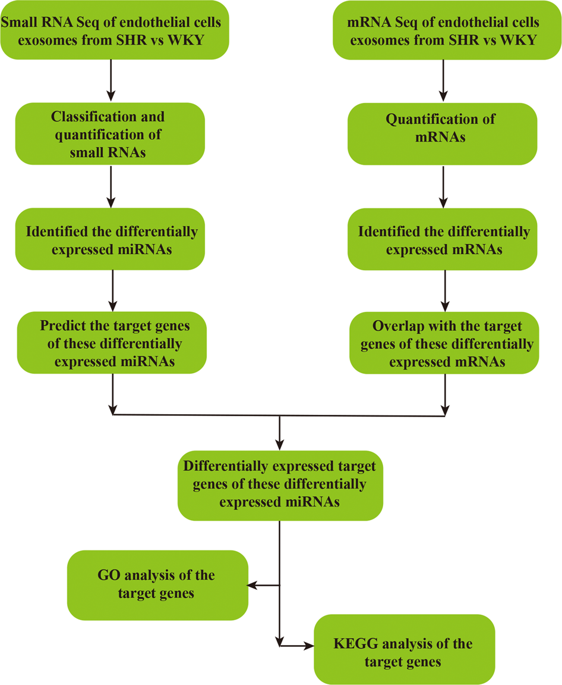当前位置:
X-MOL 学术
›
Hypertens. Res.
›
论文详情
Our official English website, www.x-mol.net, welcomes your
feedback! (Note: you will need to create a separate account there.)
Integrated exosomal miRNA and transcriptome analysis of brain microvascular endothelial cells in spontaneously hypertensive rats
Hypertension Research ( IF 4.3 ) Pub Date : 2019-10-18 , DOI: 10.1038/s41440-019-0345-0 Qingbin Wu 1 , Xiaochen Yuan 1 , Bingwei Li 1 , Ruiqin Han 2 , Honggang Zhang 1 , Ruijuan Xiu 1
Hypertension Research ( IF 4.3 ) Pub Date : 2019-10-18 , DOI: 10.1038/s41440-019-0345-0 Qingbin Wu 1 , Xiaochen Yuan 1 , Bingwei Li 1 , Ruiqin Han 2 , Honggang Zhang 1 , Ruijuan Xiu 1
Affiliation

|
Endothelial cells, which regulate arterial stiffness via endothelial-derived substances, are independently and strongly associated with hypertension. However, the exact roles of exosome miRNAs from brain endothelial cells in the development of hypertension are still not fully explored. Here, we investigated the miRNA functions systematically by examining both exosomal small RNA and mRNA of endothelial cells in Wistar Kyoto (WKY) rats versus spontaneously hypertensive rats (SHRs). Our findings revealed that miRNAs, representing ~60–70%, account for the majority of small RNAs. Moreover, we found 159 novel miRNAs in total from the unannotated reads across the diverse samples. Afterwards, 76 differentially expressed miRNAs (37 upregulated, 39 downregulated) and 1709 differentially expressed mRNAs (775 upregulated, 934 downregulated) were identified between SHRs and WKY rats, respectively. Finally, 647 genes targeted by 36 miRNAs came to our attention via identification of the target genes of those abnormal miRNAs. The differentially expressed target genes induced by miRNA changes were mapped to a number of genes involved in various gene functions and pathways. These changes lead to dysregulation of angiogenesis, axonogenesis, neuron-to-neuron synapses, focal adhesion, axon guidance, cell adhesion molecules (CAMs), adherens junction, and ECM-receptor interaction pathways. Together, our study revealed that the miRNAs are changed and contribute to the dysregulated functions and pathways of their target genes and provided more insights into their regulation mechanisms during mammalian hypertension development.
中文翻译:

自发性高血压大鼠脑微血管内皮细胞外泌体miRNA和转录组分析
通过内皮源性物质调节动脉僵硬度的内皮细胞与高血压独立且密切相关。然而,来自脑内皮细胞的外泌体 miRNA 在高血压发展中的确切作用仍未得到充分探索。在这里,我们通过检查 Wistar Kyoto (WKY) 大鼠与自发性高血压大鼠 (SHR) 的外泌体小 RNA 和内皮细胞 mRNA 系统地研究 miRNA 功能。我们的研究结果表明 miRNA,约占 60-70%,占小 RNA 的大部分。此外,我们从不同样本的未注释读数中总共发现了 159 个新的 miRNA。之后,76 个差异表达的 miRNA(37 个上调,39 个下调)和 1709 个差异表达的 mRNA(775 个上调,934 下调)分别在 SHR 和 WKY 大鼠之间鉴定。最后,通过鉴定那些异常 miRNA 的靶基因,我们注意到了 36 个 miRNA 靶向的 647 个基因。由miRNA变化诱导的差异表达的靶基因被映射到涉及各种基因功能和途径的许多基因。这些变化导致血管生成、轴突生成、神经元间突触、粘着斑、轴突引导、细胞粘附分子 (CAM)、粘附连接和 ECM-受体相互作用通路的失调。总之,我们的研究表明 miRNA 发生了变化,并导致其靶基因的功能和途径失调,并为哺乳动物高血压发展过程中的调控机制提供了更多见解。36个miRNA靶向的647个基因通过鉴定那些异常miRNA的靶基因引起了我们的注意。由miRNA变化诱导的差异表达的靶基因被映射到涉及各种基因功能和途径的许多基因。这些变化导致血管生成、轴突生成、神经元间突触、粘着斑、轴突引导、细胞粘附分子 (CAM)、粘附连接和 ECM-受体相互作用通路的失调。总之,我们的研究表明 miRNA 发生了变化,并导致其靶基因的功能和途径失调,并为哺乳动物高血压发展过程中的调控机制提供了更多见解。36个miRNA靶向的647个基因通过鉴定那些异常miRNA的靶基因引起了我们的注意。由miRNA变化诱导的差异表达的靶基因被映射到涉及各种基因功能和途径的许多基因。这些变化导致血管生成、轴突生成、神经元间突触、粘着斑、轴突引导、细胞粘附分子 (CAM)、粘附连接和 ECM-受体相互作用通路的失调。总之,我们的研究表明 miRNA 发生了变化,并导致其靶基因的功能和途径失调,并为哺乳动物高血压发展过程中的调控机制提供了更多见解。由miRNA变化诱导的差异表达的靶基因被映射到涉及各种基因功能和途径的许多基因。这些变化导致血管生成、轴突生成、神经元间突触、粘着斑、轴突引导、细胞粘附分子 (CAM)、粘附连接和 ECM-受体相互作用通路的失调。总之,我们的研究表明 miRNA 发生了变化,并导致其靶基因的功能和途径失调,并为哺乳动物高血压发展过程中的调控机制提供了更多见解。由miRNA变化诱导的差异表达的靶基因被映射到涉及各种基因功能和途径的许多基因。这些变化导致血管生成、轴突生成、神经元间突触、粘着斑、轴突引导、细胞粘附分子 (CAM)、粘附连接和 ECM-受体相互作用通路的失调。总之,我们的研究表明 miRNA 发生了变化,并导致其靶基因的功能和途径失调,并为哺乳动物高血压发展过程中的调控机制提供了更多见解。细胞粘附分子 (CAM)、粘附连接和 ECM-受体相互作用途径。总之,我们的研究表明 miRNA 发生了变化,并导致其靶基因的功能和途径失调,并为哺乳动物高血压发展过程中的调控机制提供了更多见解。细胞粘附分子 (CAM)、粘附连接和 ECM-受体相互作用途径。总之,我们的研究表明 miRNA 发生了变化,并导致其靶基因的功能和途径失调,并为哺乳动物高血压发展过程中的调控机制提供了更多见解。
更新日期:2019-10-18
中文翻译:

自发性高血压大鼠脑微血管内皮细胞外泌体miRNA和转录组分析
通过内皮源性物质调节动脉僵硬度的内皮细胞与高血压独立且密切相关。然而,来自脑内皮细胞的外泌体 miRNA 在高血压发展中的确切作用仍未得到充分探索。在这里,我们通过检查 Wistar Kyoto (WKY) 大鼠与自发性高血压大鼠 (SHR) 的外泌体小 RNA 和内皮细胞 mRNA 系统地研究 miRNA 功能。我们的研究结果表明 miRNA,约占 60-70%,占小 RNA 的大部分。此外,我们从不同样本的未注释读数中总共发现了 159 个新的 miRNA。之后,76 个差异表达的 miRNA(37 个上调,39 个下调)和 1709 个差异表达的 mRNA(775 个上调,934 下调)分别在 SHR 和 WKY 大鼠之间鉴定。最后,通过鉴定那些异常 miRNA 的靶基因,我们注意到了 36 个 miRNA 靶向的 647 个基因。由miRNA变化诱导的差异表达的靶基因被映射到涉及各种基因功能和途径的许多基因。这些变化导致血管生成、轴突生成、神经元间突触、粘着斑、轴突引导、细胞粘附分子 (CAM)、粘附连接和 ECM-受体相互作用通路的失调。总之,我们的研究表明 miRNA 发生了变化,并导致其靶基因的功能和途径失调,并为哺乳动物高血压发展过程中的调控机制提供了更多见解。36个miRNA靶向的647个基因通过鉴定那些异常miRNA的靶基因引起了我们的注意。由miRNA变化诱导的差异表达的靶基因被映射到涉及各种基因功能和途径的许多基因。这些变化导致血管生成、轴突生成、神经元间突触、粘着斑、轴突引导、细胞粘附分子 (CAM)、粘附连接和 ECM-受体相互作用通路的失调。总之,我们的研究表明 miRNA 发生了变化,并导致其靶基因的功能和途径失调,并为哺乳动物高血压发展过程中的调控机制提供了更多见解。36个miRNA靶向的647个基因通过鉴定那些异常miRNA的靶基因引起了我们的注意。由miRNA变化诱导的差异表达的靶基因被映射到涉及各种基因功能和途径的许多基因。这些变化导致血管生成、轴突生成、神经元间突触、粘着斑、轴突引导、细胞粘附分子 (CAM)、粘附连接和 ECM-受体相互作用通路的失调。总之,我们的研究表明 miRNA 发生了变化,并导致其靶基因的功能和途径失调,并为哺乳动物高血压发展过程中的调控机制提供了更多见解。由miRNA变化诱导的差异表达的靶基因被映射到涉及各种基因功能和途径的许多基因。这些变化导致血管生成、轴突生成、神经元间突触、粘着斑、轴突引导、细胞粘附分子 (CAM)、粘附连接和 ECM-受体相互作用通路的失调。总之,我们的研究表明 miRNA 发生了变化,并导致其靶基因的功能和途径失调,并为哺乳动物高血压发展过程中的调控机制提供了更多见解。由miRNA变化诱导的差异表达的靶基因被映射到涉及各种基因功能和途径的许多基因。这些变化导致血管生成、轴突生成、神经元间突触、粘着斑、轴突引导、细胞粘附分子 (CAM)、粘附连接和 ECM-受体相互作用通路的失调。总之,我们的研究表明 miRNA 发生了变化,并导致其靶基因的功能和途径失调,并为哺乳动物高血压发展过程中的调控机制提供了更多见解。细胞粘附分子 (CAM)、粘附连接和 ECM-受体相互作用途径。总之,我们的研究表明 miRNA 发生了变化,并导致其靶基因的功能和途径失调,并为哺乳动物高血压发展过程中的调控机制提供了更多见解。细胞粘附分子 (CAM)、粘附连接和 ECM-受体相互作用途径。总之,我们的研究表明 miRNA 发生了变化,并导致其靶基因的功能和途径失调,并为哺乳动物高血压发展过程中的调控机制提供了更多见解。











































 京公网安备 11010802027423号
京公网安备 11010802027423号